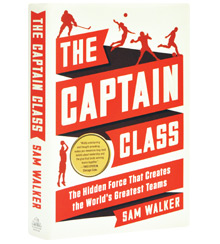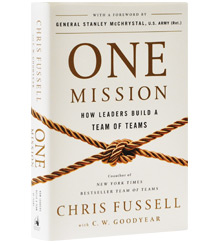Best Business Books 2017: Leadership
Captains Courageous and Agile
Sam Walker
The Captain Class: The Hidden Force That Creates the World’s Greatest Teams (Random House, 2017)
*A TOP SHELF PICK
Chris Fussell with C.W. Goodyear
One Mission: How Leaders Build a Team of Teams (Portfolio/Penguin, 2017)
Susan David
Emotional Agility: Get Unstuck, Embrace Change, and Thrive in Work and Life (Avery/Penguin, 2016)
A number of themes have persistently cropped up in leadership literature over the last two decades. The difficulty of spurring hearts-and-minds engagement in a high-pressure environment. The need to distinguish leadership from celebrity. The challenge of building cohesive teams while rewarding exceptional performance. And the integration of neuroscientific research into our understanding of group behavior.
This year’s three best business books on leadership bring fresh, persuasive, and arresting perspectives to these conundrums. And they derive their power from the fact that they are rooted not in theory but in hard-earned experience and rigorously assembled data. Most notably, they make clear that even in this age of algorithms, artificial intelligence, and bots, it is still human values such as flexibility, humility, and the courage to speak truth to power that define excellence.
Captain Theory
The best of the crop is Sam Walker’s The Captain Class: The Hidden Force That Creates the World’s Greatest Teams. This wonderfully written and wildly entertaining study of the most winning sports teams in history has more to say about leadership, engagement, and the chemistry that sparks and sustains extraordinary achievement than a decade’s worth of leadership books.
Walker, deputy editor for enterprise at the Wall Street Journal and founder of its daily sports feature, set out to discover the secret sauce of freakishly successful major sports teams by devising a complex series of weighted metrics with which he could identify the best of the best — teams that sustained unquestionable dominance over time. In his attempt to figure out what the 16 teams he identified as the Tier One group had in common, Walker closely analyzed the 1956–69 Boston Celtics, who won 11 championships in 14 years, including eight in a row.
Now, the Celtics did not have a superstar player à la Michael Jordan, who was regarded as the best in the league in his heyday. The team’s stats for points scored or average margin of victory weren’t overwhelming. It had different coaches during its remarkable streak. But Walker noticed that the playing career of center Bill Russell overlapped precisely with the Celtics’ period of dominance. Russell also served as captain of the team starting in 1963. And when he retired in 1969, the Celtics promptly collapsed.
When Walker reexamined his data, he discovered that every one of the 16 Tier One teams he had identified had a single player whose tenure coincided with the team’s streak, and that that player had usually served as captain.
Hence the captain theory was born. Walker posits that team captains play a major and indeed determinative role in the phenomenon of outsized success. But why? As a business journalist, Walker knows that correlation does not equal causation. So he set out to answer two questions. First, given the highly variable nature of the position, what do spectacularly successful team captains actually do for their teams? And second, what qualities and characteristics do the highly diverse Tier One captains, in sports as diverse as international men’s ice hockey and international women’s volleyball, have in common?
He found that the team captains provided strong and passionate internal leadership. They held sway over the locker room by speaking to their teammates as peers, counseled them on and off the field, challenged them, protected them, kept their secrets, resolved their disputes, enforced standards, and inspired fear when required. As one teammate said of Buck Shelford, the Maori captain of the 1986–90 New Zealand All Blacks of the International Rugby Union, “He was a guy you could walk over broken glass for, because he just had that manner about him.”
Great captains, Walker concluded, are what baseball managers call “the glue guys,” those players who devote themselves to unifying the team. It’s perhaps not surprising, then, that the greatest captains are rarely the most talented or dazzling players, the high performers so lionized in corporate literature today. Humility as well as toughness is required. Didier Deschamps, a French soccer midfielder, captained France’s national team to a World Cup championship in 1998 and the European Championship in 2000, and captained his club team when it won an important championship. He described himself happily as a water carrier, a porteur d’eau, whose job was to get the ball to other players. (Deschamps is now the coach of France’s national team.)
Walker spends the bulk of the book exploring the seven traits shared by his deeply quirky elite captains. These include extreme doggedness, a tendency to play aggressively to the edge of the rules, a willingness to take on thankless jobs, a low-key and democratic communication style, an ability to motivate others with passionate nonverbal displays, the courage to stand apart (and stand up to management when necessary), and the ironclad emotional control that enables them to keep their heads clear of distractions.
Even in this age of algorithms, it is still human values such as flexibility, humility, and the courage to speak truth to power that define excellence.
These practices are described using vivid, often thrilling examples of how the captains approached competition, inspired and communicated with their teammates, challenged coaches and referees, and coaxed the best from other players. Mireya Luis, who captained the Cuban women’s team to three consecutive World Cups, psychologically outwitted the favored Brazilians through her use of what Walker calls intelligent fouls. And Valeri Vasiliev, legendary defenseman of the Soviet Union’s Red Army men’s ice hockey team, led his team on a sustained winning streak following its devastating loss in the 1980 Lake Placid Olympics after reaming out the coach on the return flight for singling out specific players for blame.
Walker unearths a quote from a clinical psychology paper published in a textbook on which Tim Duncan, who won five NBA championships with the 1997–2016 San Antonio Spurs, collaborated as an undergraduate. Titled “Blowhards, Snobs, and Narcissists: Interpersonal Reactions to Excessive Egotism,” the paper makes the case that self-centered people who project arrogance through speech and body language can weaken a group or team’s cohesion. Duncan went on to exemplify the opposite characteristics in his nearly two decades with the Spurs, devoting himself to setting up plays for teammates. Sportswriters dubbed the Spurs’ longtime captain the “most boring superstar in the history of sports.” The record books tell us otherwise.
Mission Critical
Business isn’t a military conflict any more than it is an athletic conflict. But, as is the case with sports, the armed forces have a lot to teach companies about leadership. That’s evident from reading Chris Fussell’s One Mission: How Leaders Build a Team of Teams. It’s an elegantly written and vivid account of what happens when superbly trained and highly resourced teams that operate as part of a bureaucratic structure confront a decentralized and fluid network of underprepared and barely resourced competitors that are nonetheless fiercely aligned around a persuasive common narrative. And it offers a rich template for effective action. In the process, One Mission demonstrates precisely why 20th-century managerial innovations such as management by objectives and vertically cascading strategic alignment are doomed in an environment characterized by complexity, unpredictability, and speed.
On deployment in Iraq in 2003, Fussell found a profound source of engagement and purpose in the camaraderie and distinctive traditions of the elite SEAL group to which he belonged. Yet his operations unit served as part of a joint task force, and even on that first deployment he noticed that the constituent units that made up the force often operated at cross-purposes despite their common and oft-stated mission, “to defeat al Qaeda in Iraq.” The Ranger units, CIA analyst teams, State Department liaisons, NSA signals intelligence partners, and SEAL platoons all had proud and insular tribal cultures that constrained relationships between teams. This made it difficult for members to share information and trust colleagues from other “clans.”
This deficiency was particularly acute — and often lethal — given that the SEALs’ opponent, al Qaeda, had perfected a fluid operational structure and inculcated extraordinary cohesion among its dispersed units. The enemy’s rank and file, Fussell noted, could “move with speed and individual initiative, collaborating with one another and aligning their otherwise isolated actions free from formalized approval chains.”
Thus the joint task force, although far more impressive on paper than the enemy, was weakened by the individual cultures that made its constituents great. “We had excellence, talent, and capability; they had a uniting calling.… We were a strictly ordered machine…they were an organic movement.” In other words, it was a typical asymmetric 21st-century encounter between a powerful but bureaucratic behemoth and an underfunded but passionate startup.
Deployed in Afghanistan the following year, Fussell saw the physical manifestation of the cultural silos in the state-of-the-art operations compound at Khowst. There, high walls, cipher locks, and rigid security procedures inhibited cross-functional relationships, symbolizing the “operational divide that was metastasizing across the Task Force’s ordered body.”
Enter General Stanley McChrystal, whom Fussell would later serve as aide-de-camp before leaving military service in 2008, and with whom he (and others) collaborated on the 2015 book Team of Teams: New Rules of Engagement for a Complex World (Portfolio/Penguin). McChrystal recognized that the tactical screwups that kept occurring in an unpredictable war against an unpredictable enemy were the inevitable result of closely protected team cultures that inhibited synchronization.
As many private- and public-sector leaders have learned, silos cannot be dismantled by fiat or by the creation of nice org charts with a weblike shape. Dotted lines mean nothing when trust and relationships are absent. What’s needed are processes, practices, and team-wide traditions that get colleagues speaking honestly with one another.
Prior to McChrystal’s intervention, leaders of the task force had used “Congressional hearing”–style events to debrief subordinates of constituent groups — a tactic that encouraged only vertical alignment. McChrystal replaced this format with a digitally enabled daily forum in which members of operations and intelligence teams at all levels and in all locations exchanged newly discovered, often imperfectly formed ground-level information with one another and with senior leaders in real time. By assembling a complex but up-to-date picture of a continually evolving situation via constituents with vastly different charges, perceptions, and domains of expertise, the military could encourage better decision making and collaboration across disciplines.
Fussell’s precise and detailed description of these forums is a high point in his narrative, as are his pointed observations about the futility of mission statements that originate at the top. He argues that the innovations that the joint task force put in place can have wide application in a range of organizations that struggle with bureaucracy, silos, and cross-unit mistrust. For example, he cites research showing that although 84 percent of managers express confidence in their direct line superiors and subordinates, only 9 percent feel confidence in peers from other functions and units.
In his post-military career, as part of McChrystal’s consulting group, Fussell spreads the gospel of inclusive action forums and horizontal alignment to business clients. One Mission presents engaging case studies of how task force innovations have helped five nonmilitary enterprises address diverse conundrums. Standouts included Intuit’s struggle to achieve scale while maintaining the speed of a startup through rigorous focus on an aligning narrative, and the Oklahoma Office of Management and Enterprise Services’ use of a virtual forum to build relationships among siloed units and defeat a bureaucratic culture that had come to “feel like a dictatorship.”
Fussell’s specific and bracing descriptions of how the practices can be applied gets to the heart of how significant culture change actually occurs. The joint task force managed to shift a massive and highly centralized organization whose stated goal was defeating al Qaeda into an organization committed to building the kind of culture required for defeating a complex and continually evolving adversary.
Emotionally Agile
Since it was published in 1995, Daniel Goleman’s Emotional Intelligence has had a big impact on organizations. Recruiters typically consider “EQ” (an applicant’s emotional intelligence quotient) when considering candidates for hiring and promotion. HR departments test for EQ when composing teams. Coaches work with countless executives to help them improve their EQ.
Now comes Susan David, a psychologist on the faculty of Harvard Medical School, with Emotional Agility: Get Unstuck, Embrace Change, and Thrive in Work and Life, an insightful book whose promise-the-moon subtitle does it a disservice. As a concept and a practice, emotional agility (EA) seems poised to enter the lexicon of organizations. If EQ reflects your level of skill in managing others, EA reflects your level of skill in managing yourself. Given the recent emphasis on self-awareness as an essential leadership trait — and the stunning institutional damage that can be done by leaders who lack this quality — the author’s timing seems particularly astute.
David defines emotional agility as the ability to change or maintain one’s behaviors in a way that aligns with what one values and intends. Our capacity to be agile is undermined when we resort to familiar but rigid responses to situations, stimuli, and the speech or actions of others. Doing so may feel comfortable, but it impairs our ability to choose our responses. Instead, we operate on autopilot.
Given the speed and demands of today’s environment, autopilot presents a powerful temptation. Yet this approach leaves no opening for the space between stimulus and response that Austrian neurologist and psychiatrist Viktor Frankl, one of David’s heroes, identifies as the only true source of personal growth, freedom, meaning, and fulfillment.
Although the framework of Emotional Agility can feel a bit arbitrary, David’s insights are often riveting and refreshingly counterintuitive. Her examples are clear and anything but run-of-the-mill. For instance, her take on the role negative emotions and bad moods play in building emotional agility offers an invigorating antidote to a culture in which happiness has become not only an unquestioned goal but the presumed best metric of mental health. Yet while recognizing the advantages that positive emotions provide, David notes that our experience of sadness, anger, fear, and guilt can instill perseverance, spur attention, improve memory, encourage compassion, clarify thought, and make us less prone to confirmation bias.
By contrast, lionizing positivity creates rigid responses by blinding us to data that contradicts the cheerful story we insist on telling ourselves. In our quest to be upbeat, she writes, we dismiss cautionary signals, jump to unwarranted conclusions, make hasty or risky decisions, and harbor unrealistic expectations that may culminate in bitter disappointment.
Perhaps most arrestingly, David demonstrates why trying to smother distress with positive affirmations, a widely recommended practice, is ineffective given the chemistry of the human brain. She invites us to instead pay attention to our negative emotions and consider what function they might serve, using the shorthand question “What the func?”
Leaders can also benefit from how David connects the dots between emotional agility and ethical behavior. She argues persuasively that identifying and taking responsibility for our emotions is essential if we are to act with integrity and honor. Solid values are the only possible counterweight to the phenomenon of negative social contagion, described for all time in Elias Canetti’s classic Crowds and Power (Gollancz, 1962), but given new urgency and form in the social media era.
Reprint No. 17412
Author profile:
- Sally Helgesen is a contributing editor of strategy+business, an author, speaker, and leadership development consultant whose most recent book is The Female Vision: Women’s Real Power at Work (with Julie Johnson; Berrett-Koehler, 2010).






